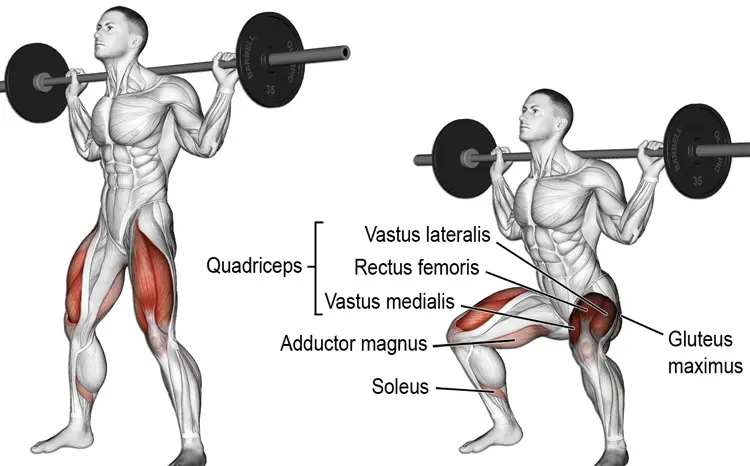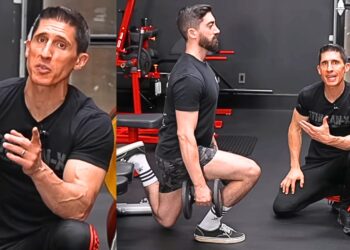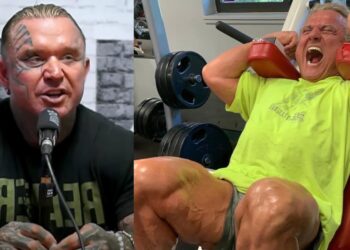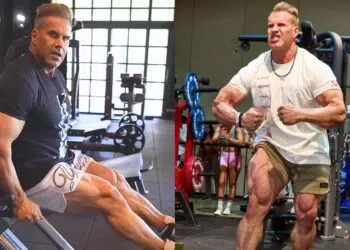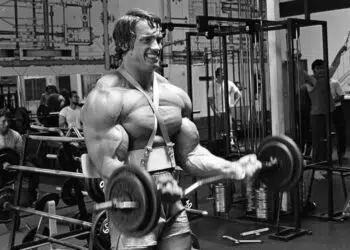An old athletics coach of mine once told me that a workout without squats is not really a workout. This point of view makes a lot of sense, given how productive squats can be for building strength, muscle mass, and performance.
Squats aren’t just popular with bodybuilders; athletes do them too. It seems that squats can help you run faster, jump higher, and kick harder. In fact, squats can even help you lose weight and burn fat.
With so many benefits on offer, it’s hardly surprising that the barbell squat is often called the king of exercises. For the most part, this is a title that’s fully deserved.
However, the barbell squat is not a perfect exercise. For example, it hits your quads far harder than your hamstrings (1), requires good lower body mobility to perform correctly, and can even be dangerous if taken to failure.
If you want to do barbell squats, you’ll need a barbell (obviously!), a squat rack, and plenty of weight. Ideally, and especially if you are using heavy loads, you should squat in a power rack. That way, if you cannot complete a rep, you won’t find yourself pinned under a heavy bar. At the very least, you should squat with a spotter close at hand to help you if you get into trouble.
Some people also find barbell squats uncomfortable. After all, you’ll need to rest and hold the bar across your upper back (back squats) or the front of your shoulders (front squats), and both positions can hurt. That’s why a lot of lifters use bar pads.
Level Up Your Fitness: Join our 💪 strong community in Fitness Volt Newsletter. Get daily inspiration, expert-backed workouts, nutrition tips, the latest in strength sports, and the support you need to reach your goals. Subscribe for free!
The good news is that barbell squats are not compulsory. There are plenty of alternative leg exercises you can do that are just as effective and do not involve resting a barbell on your back or shoulders.
In this article, we reveal the 13 best leg exercises that AREN’T barbell squats!
Barbell Squat Anatomy
One of the most appealing things about the barbell squat (front or back) is how many muscles are trained when doing them. In fact, squats work pretty much every muscle in your lower body and a few upper body muscles, too.
However, the main muscles trained during squats are:
Quadriceps
Known as the quads for short, these are the muscles located on the fronts of your thighs. The quads are the primary muscles trained during barbell squats. There are four quads – the rectus femoris, vastus lateralis, vastus medialis, and vastus intermedius. All four work together to extend your knees during squats.
Gluteus maximus
Located on the back of your hips and known as your glutes for short, this is the largest muscle in your body and is basically your butt. The glutes extend your hips, and the deeper you squat, the more work they have to do.
Hamstrings
The hamstrings flex your knees and extend your hips. Located on the back of your thighs, the three hamstring muscles are the biceps femoris, semimembranosus, and semitendinosus.
While the hamstrings ARE involved in squats, their role is secondary to the quads. That’s because as your hips and knees flex, the length of the hamstrings remains relatively unchanged. You’ll feel them working, but the hamstrings aren’t contracting as hard as the quads during squats.
Adductors
The adductors draw your thighs in toward the midline of your body. The three adductor muscles are longus, brevis, and magnus, meaning longest, shortest, and biggest. During squats, the adductors help stop your knees from falling outward. The Adductor magnus also plays a part in hip extension.
Abductors
Located on the outside of your hips and thighs, the abductors lift your leg out and away from the midline of your body. The main abductors are gluteus minimus and medius, and the tensor fascia latae. During squats, the abductors prevent your knees from falling inward.
Erector spinae
Erector spinae is the collective name for the muscles that run up either side of your spine. These muscles stabilize your spine during squats and prevent you from falling forward. Holding a barbell across your shoulders creates a long lever, so these muscles are very active during barbell squats, especially the high-bar variation.
Core
The core is the collective name for the muscles of your midsection, including the obliques, rectus abdominis, and transverse abdominis. These muscles work together to create intra-abdominal pressure and stabilize your lumbar spine.
Barbell squats definitely work your core, but contrary to popular opinion, squats are NOT enough to train your abs, and they’ll undoubtedly benefit from some direct training (2).
Related: Do Squats Work Your Abs?
Triceps surae
The triceps surae is the collective term for the two calf muscles, gastrocnemius and soleus. These muscles work together to help control and stabilize your ankles during squats. However, calf engagement during squats is relatively low.
While barbell squats DO work a lot of muscles, you don’t have to do them if you don’t want to. In fact, there are plenty of alternatives that can be just as effective as front or back barbell squats.
13 Best Barbell Squat Alternatives
No barbell? No squat rack? Or maybe you just find barbell squats uncomfortable? Don’t worry; you can still develop strong, functional, aesthetically-pleasing legs! Here are 13 of the best barbell squat alternatives.
1. Leg press machine
One of the most common problems with barbell squats is how hard it can be to stabilize your lower back – even if you have a strong core. For example, many lifters feel barbell squats more in their lower backs than their legs. Leg presses support your lower back, so you are free to focus on pushing your legs to their limit. You can also adjust your foot position to emphasize different leg muscles.
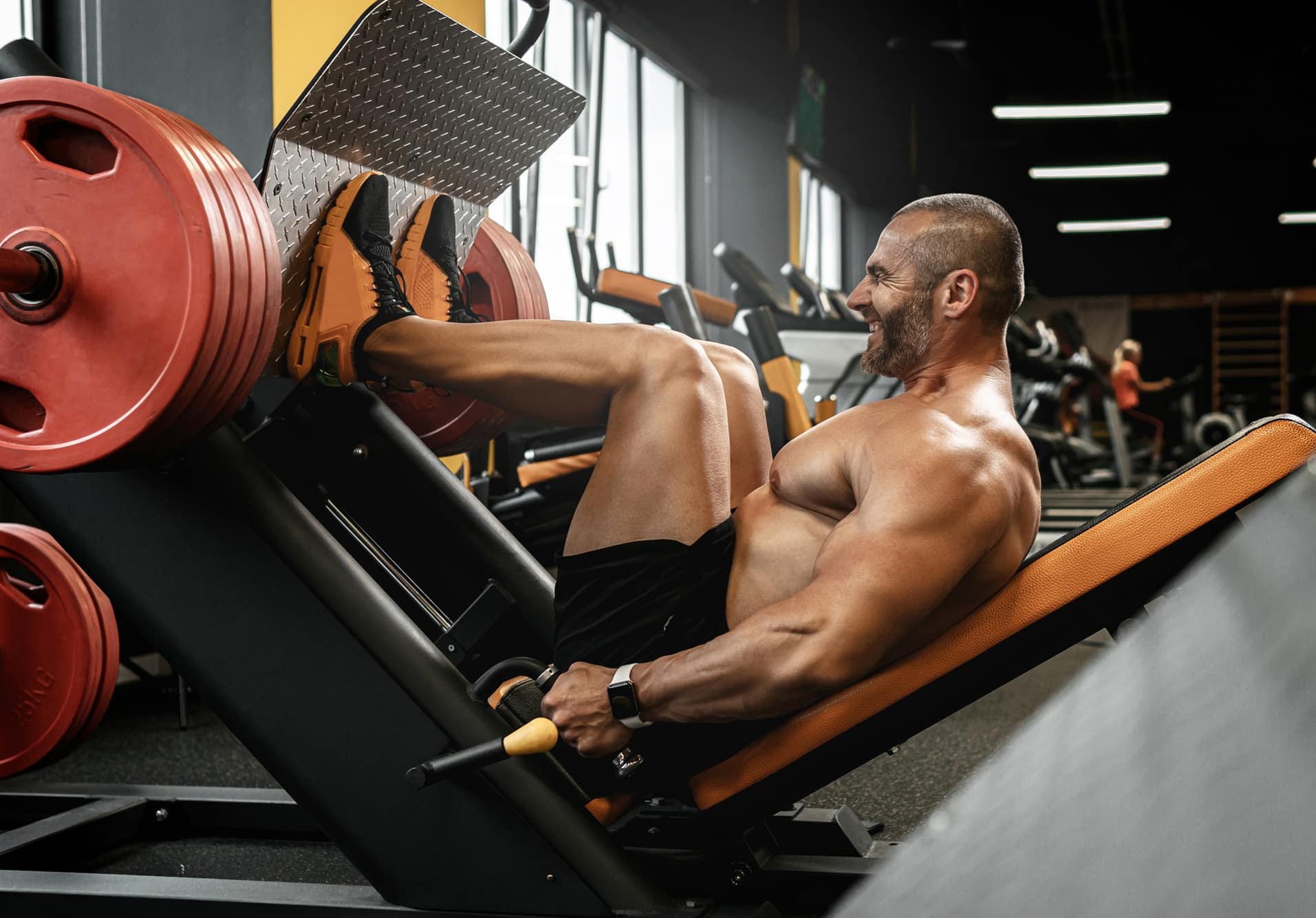
How to do it:
- Sit on the leg press and slide your butt down and into the bottom of the seat. Place your feet on the footplates so they are between shoulder and hip-width apart.
- Extend your legs and press the weight up. Flip the safety catches out to the side so the weight sled is free to move. Grip the support handles and brace your abs.
- Bend your knees and descend as far as your flexibility and knee health allows. Do not let your lower back round. Instead, keep it pressed into the backrest.
- Without bouncing, drive the weight back up, stopping just short of full knee extension.
- That’s one rep – keep going!
Pro tip: There are lots of different leg press machine manufacturers and designs, and each one works slightly differently. Make sure you use the leg press at your gym according to any instructions provided with the machine or as directed by the gym staff.
2. Hack squat machine
The hack squat machine is an alternative to the old-school barbell back squat. But, if you don’t want or can’t do barbell squats, that exercise is probably off the menu, too. The hack squat machine provides back support and emphasizes your quadriceps. In fact, you probably won’t feel your hamstrings working at all during this exercise.
How to do it:
- Stand on the footplate and place your shoulders under the padding. Position your feet according to your goal, i.e., feet slightly back and together to emphasize the quadriceps or wider apart and further forward to increase general leg muscle activation.
- Unrack the weight and slowly squat down so your upper legs are at or slightly below parallel.
- Squat back up through your heels into a standing position.
- Complete the desired number of reps.
Pro tip: Try doing hack squats on your tiptoes and pushing your knees forward for an even more intense quad workout. This was a favorite exercise of “The Quad Father” Tom Platz. However, this variation can be hard on your joints, so don’t go too heavy too soon, and forget it if it bothers your knees.
3. Goblet squat
Goblet squats are a great alternative to barbell squats. All you need is a single kettlebell or dumbbell. They’re also much easier to master and far more forgiving than barbell squats. As a final advantage, if you cannot finish a rep, you can simply drop the weight on the floor in front of you. You don’t need a squat rack for goblet squats.
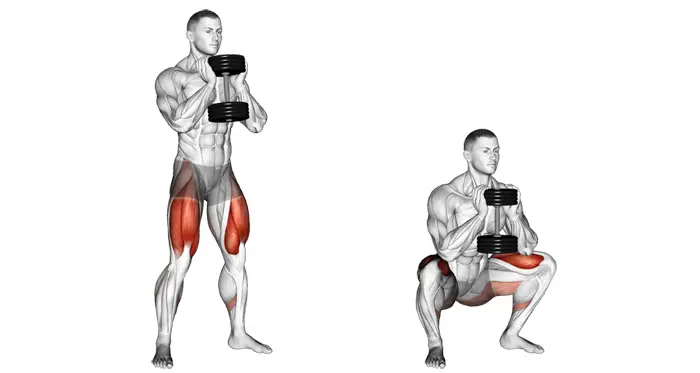
How to do it:
- Stand with your feet about shoulder-width apart, toes turned slightly outward.
- Hold a kettlebell or dumbbell in front of your chest and just below your chin. Pull your shoulders down and back, and brace your core. Look straight ahead.
- Keeping your torso upright, bend your knees, and squat as deeply as you can without rounding your lower back.
- Stand up, stopping just short of locking your knees to keep the tension on your muscles.
- Descend again and repeat for the required number of repetitions.
Pro tip: Increase squat depth and hit your quads harder by raising your heels on weight plates. This is called a cyclist squat.
4. Dumbbell deadlift
Despite the name, the dumbbell deadlift is actually more of a squat. The main difference is that instead of the weight resting on your back or shoulders, you hold it in your hands with your arms by your sides. This is a very functional and accessible alternative to barbell squats that’s ideal for home lifters.
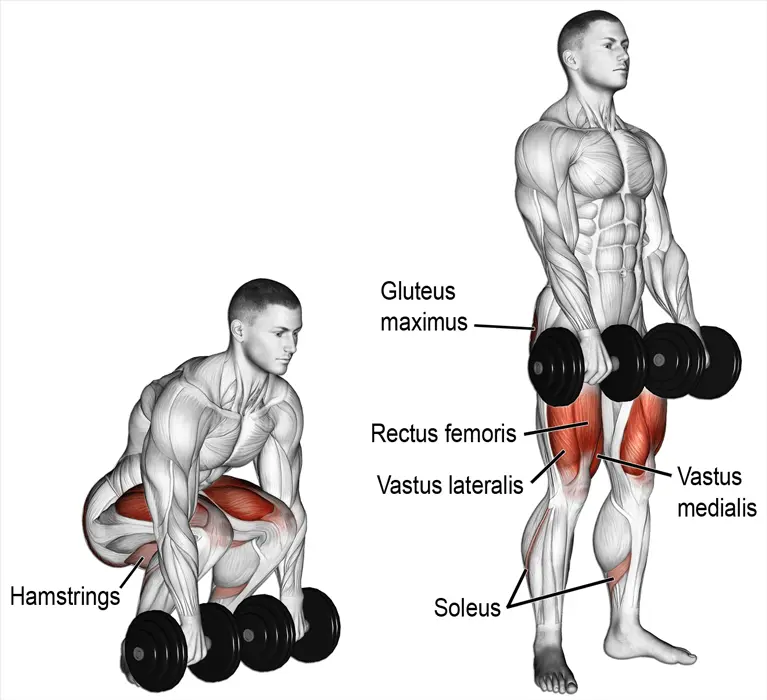
How to do it:
- Place your dumbbells on the floor and stand between them, feet about shoulder-width apart. The dumbbell handles should be parallel.
- Brace your core and squat down to grasp the weights. Pull your shoulders down and back, lift your chest, and drop your hips.
- Drive your feet into the floor and, without rounding your lower back, stand up straight. Take care not to let your hips rise faster than your shoulders.
- Pause at the top for a second and then lower the weights back to the floor. Again, do not round your lower back.
Pro tip: You can also start with exercise from standing. This is a good option if you don’t want to descend all the way to the floor.
5. Trap bar deadlift
If you find that the weights rub against your legs during dumbbell deadlifts, using a trap bar should provide some relief. A trap bar, also known as a hex bar, is a frame that you stand inside, which keeps the weights away from your legs. Most gyms have a trap bar, and they’re also ideal for home use. Using a trap bar means you can train your legs hard and heavy without needing a squat rack.
How to do it:
- With the trap bar on the floor, stand between the handles. Ideally, the handles should be around nine inches above the floor. Using bumper plates should ensure this. Some trap bars have raised handles, so you don’t have to bend over so far, which is handy when using small-diameter weight plates.
- Position your feet, so they’re between shoulder and hip distance apart. Your stance may be determined by the size and design of the trap bar you are using. Squat down and grab the handles, so your hands are facing inward.
- Straighten your arms, lift your chest, and lower your hips. Pull your shoulders down and back, and brace your core. Your lumbar spine should be slightly arched.
- Without bending your arms or rounding your lower back, drive your feet into the floor and stand up straight. Do not lean back at the top or attempt to bend your arms, as this could result in injury.
- Reverse the movement and lower the bar back down to the floor. Reset your core and grip and repeat it.
Pro tip: Trap bar deadlifts can be tough on your hands. If you are using heavy weights, you can boost your grip strength and do more reps by wearing lifting straps.
6. Lunge
Barbell squats may look dissimilar, but they actually work many of the same muscles. In fact, on closer inspection, you’ll soon see that lunges are essentially squats done with one foot in front of the other.
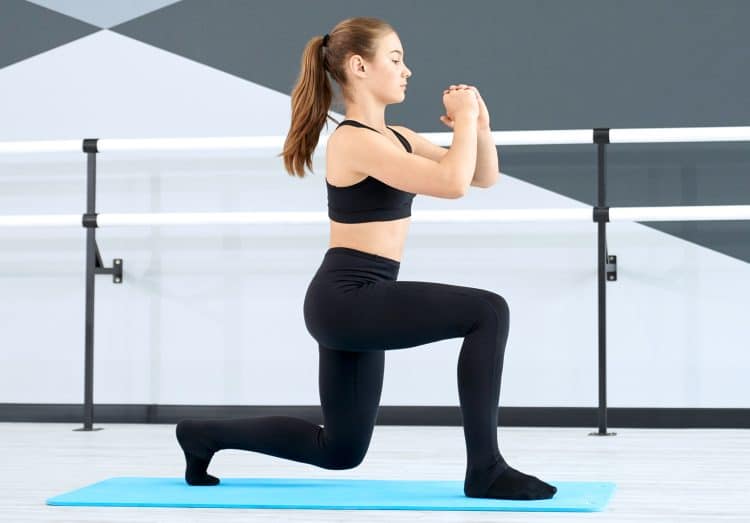
There are lots of different lunge variations, and they’re all excellent alternatives to barbell squats. Your options include:
- Forward lunges
- Backward lunges
- Walking lunges
- Lateral lunges
- Deficit lunges
- Lunge jumps
Readall about lunges, including how to do these variations, in this detailed guide.
Pro tip: Make lunges more quad-dominant by using shorter steps. Alternatively, taking longer steps will hit your glutes and hamstrings more.
Level Up Your Fitness: Join our 💪 strong community in Fitness Volt Newsletter. Get daily inspiration, expert-backed workouts, nutrition tips, the latest in strength sports, and the support you need to reach your goals. Subscribe for free!
7. Bulgarian split squat
If you like lunges, you’ll probably love Bulgarian split squats. Also known as rear foot elevated split squats, this exercise uses a larger range of motion than lunges. Bulgarian split squats put more weight on your front leg to make them more quads-dominant.
How to do it:
- Stand with your back to a knee-high exercise bench. Bend one leg and place the top of your foot on the bench behind you. Hop forward and into a split stance.
- Bend your legs and lower your rear knee down toward the floor. Keep your lower back straight and your chest and head up. Look straight ahead. Try to keep your front shin close to vertical, and do not let your knee move beyond your toes.
- Push down through your front leg and stand back up. You should feel that about 60% of your weight is on your front leg, and about 40% is on your rear leg.
- Do the same number of reps on each leg.
Pro tip: Make this exercise more challenging by raising your front foot by four to six inches. This is called a deficit Bulgarian split squat and increases the load and range of motion on your front leg:
8. Wall squat
Also known as a wall sit, this exercise uses an isometric or static contraction to work your quads without movement or equipment. Wall squats are ideal for home exercisers and a great way to target your thighs without resorting to leg extensions or squats.
How to do it:
- Find a smooth, sturdy wall to do this exercise against. Ensure the floor is not slippery, or your feet may slide from under you.
- Stand with your back to the wall, feet about 24 inches from the baseboard. Your feet should be between hip to shoulder-width apart.
- Lean your back against the wall and slide down until your thighs are roughly parallel to the floor. Your shins should be vertical. Maintain good posture throughout.
- Without resting your hands on your thighs, use your legs to push your back against the wall.
- Do not hold your breath, as doing so will cause your blood pressure to rise.
- On completion, either slide down the wall and sit on the floor to rest or use your hands on the wall to help you stand up.
Pro tip: Instead of trying to see how long you can hold a wall squat for, push as hard as you can to fatigue your muscles within a predetermined time, e.g., 20 seconds. This is more effective for building muscle mass and strength.
9. Squat jump
Squat jumps are an explosive exercise that will improve your muscle power. Muscle power is your ability to generate force quickly. Power exercises are ideal for athletes and, done for moderate to high reps, are a good conditioning and fat-burning exercise. However, they can be hard on your joints, especially if you suffer knee pain or are overweight.
How to do it:
- Stand with your feet about shoulder-width apart.
- Squat down until your thighs are roughly parallel to the floor. Swing your arms behind you.
- Swing your arms forward for extra momentum, and jump into the air as high as possible.
- Land on slightly bent knees to absorb the landing shock, and then descend into another rep.
Pro tip: Take the impact out of this exercise by jumping up and onto a plyo box. This is called box jumps and is a joint-friendly alternative to squat jumps:
10. Sissy squat
There is nothing easy about the sissy squat. In fact, this old-school quad exercise is a real quad killer! It’s one of the few exercises that fully extends your rectus femoris muscle and is sure to leave you with shaky, burning thighs. Sissy squats are the bodyweight equivalent of the leg extension machine.
How to do it:
- Stand next to a wall or some other object you can use for balance.
- Rise up onto your tiptoes.
- Push your hips and knees forward and squat down as you simultaneously lean back. Descend as far as you can, ideally until your shins are roughly parallel to the floor or your knees touch down.
- Drive your toes into the floor and stand back up.
- Tense your quads and glutes at the top of each rep and repeat.
Pro tip: You can make sissy squats even more challenging by holding a weight plate across your chest or a dumbbell in one hand. Use your free arm for extra balance and support.
11. Air squat
The great thing about air squats is that they don’t require any equipment. That’s what “air” refers to; no added resistance. The air squat is a CrossFit staple and an excellent alternative to barbell squats. However, you’ll probably need to do high reps sets to fatigue your legs, e.g., 30-50 or even more.
How to do it:
- Stand with your feet roughly shoulder-width apart, toes turned very slightly outward. Hold your arms down by your sides, look straight ahead, and pull your shoulders down and back. Brace your core.
- Bend your knees, push your hips back, and squat down until your hips are at least level with your knees and your thighs are parallel to the floor.
- Descend further if your mobility and knee health allow. Do not round your lower back. Instead, make sure your heels stay firmly planted on the floor.
- Stand back up, fully extending your knees and hips at the top of each rep.
- Reset your core, breathe, and repeat.
Pro tip: If you struggle to keep your torso upright during air squats, raise your arms in front of you to act as a counterbalance. Experiment with a broad, standard, and narrow stance to see which works best for you.
12. Plié Squat
Plié is a French term meaning to bend. A plié is the take-off and landing position for most jumps in ballet. Ballet dancers would probably turn up their noses at plié squats as it’s pretty different from what you’ll see in something like Swan Lake!
However, while the plié squat bears little resemblance to the famous ballet movement, it’s still a very useful exercise and an excellent alternative to barbell squats. It’s especially good for targeting the adductors and glutes.
How to do it:
- Stand with your feet wider than shoulder-width apart. Turn your toes outward to about 45 degrees. You can turn your feet out more if your flexibility allows. However, ensure this movement comes from your hips and NOT your knees. Your knees and toes should point in the same direction.
- Stand up tall, brace your abs, and look straight ahead. You can also raise your arms out to the side or in front of you for balance if you wish.
- Keeping your torso upright, bend your legs, push your knees out, and descend until your thighs are roughly parallel to the floor. Try not to lean forward, and do not allow your lower back to round.
- Stand back up and repeat.
Pro tip: Work even more muscles by doing plié squats on your tiptoes. While this does require more balance, it will also ensure your calves get a workout along with your quads, glutes, and hamstrings.
13. Cable front squat
Goblet squats are an excellent exercise for building stronger, more muscular quads. Usually done with a dumbbell or kettlebell, you can also do this exercise using a cable machine. With no weights to drop on your feet, cable goblet squats are an excellent exercise for beginners and more advanced lifters who want to train to failure in complete safety.
How to do it:
- Attach a rope handle or straight bar to a low pulley. Hold your chosen handle in front of your chest and just under your chin. Pull your shoulders down and back and brace your core.
- Take a small step backward and stand with your feet about shoulder-width apart, toes turned slightly outward.
- Bend your knees and squat down until your thighs are roughly parallel to the floor. Do not round your lower back.
- Stand back up and repeat.
Pro tip: Increase glute engagement by using a booty band around your knees, or hit your quads harder by placing your heels on weight plates.
FAQs
1. So, are you saying I don’t have to do barbell squats ever again?
That’s right, you don’t HAVE to do barbell squats and the king of exercises is not compulsory. However, you should include squat-like exercises in your training. That’s because the squat is more than just an exercise; it’s also a movement pattern that most people do many times a day.
So, by all means, drop barbell squats from your workouts, and do any of the 13 exercises in this article instead. They all offer the benefits of barbell squats but do not involve holding a weight on your back or shoulders.
2. How many reps should I do?
It’s usually said that different training goals require different rep ranges. Typically, this means:
- Endurance – 15-30 reps
- Hypertrophy – 6-12 reps
- Strength – 1-5 reps
However, recent studies suggest that, for muscle growth, the number of reps performed is not really a factor providing you take your sets to within a few reps of failure (3). That’s good news because for some exercises, your only variable is the number of reps performed because you cannot always add weight, e.g., for air squats.
This means your actual rep range can vary from 6-30 reps or so. However, more than 30 reps per set probably won’t be effective as the load is too light, i.e., well below 30-40% of your 1RM.
That said, if you want to build strength, you should use heavy weights for lower reps, typically five or fewer per set.
3. Can I train my legs every day?
Providing you keep your volume low, don’t train too hard, and rotate exercises from day to day, there is no reason not to work your legs with high-frequency training. In fact, it could be very advantageous, especially for more advanced lifters.
However, suppose you are a beginner or early intermediate with a year or less of training experience. In that case, you should probably limit yourself to 2-3 leg workouts per week.
4. Are squats bad for your knees?
Squats are not bad for your knees. However, poorly performed squats are. Squatting is an entirely natural movement and, in many cultures, is a working and resting posture. People who find squats hard or painful often have tight muscles, limited mobility, or a pre-existing joint condition, e.g., arthritis.
If squats hurt your knees, you should reduce squat depth, work on your flexibility, and get a check-up to see if you have an underlying joint issue that affects your ability to squat. But, if you can squat without discomfort, you should continue squatting frequently to preserve your functional capacity for this all-important movement.
5. If squats aren’t so good for the hamstrings, what other exercises can I do for my legs?
It’s true; squats are a knee-dominant exercise, so they aren’t the best way to develop your hamstrings. The hammies are involved in squats, but their involvement is relatively low. So, to strengthen your hamstrings, you need to target them more directly.
The functions of the hamstrings are knee flexion and hip extension, and the best way to work your hamstrings is by doing both of these movements in training. Your options include:
- Seated leg curls
- Lying leg curls
- Standing leg curls
- Cable leg curls
- Suspension trainer/gymnastic ring leg curls
- Deadlifts
- Romanian deadlifts
- Hip thrusts
- Hip bridges
- Glute/ham raises
- Reverse hyperextensions
- Nordic curls
More Squat Alternative Exercises:
- Home Squat Alternatives for Strong, Sculpted Legs
- Smith Machine Squat Alternatives for Powerful, Muscular Legs
- Bulgarian Split Squat Alternatives for Stronger, More Athletic Legs
- Front Squat Alternatives for Mass, Strength, and Athletic Performance
- The Best Hack Squat Alternative for Bigger, Stronger Legs
Barbell Squat Alternatives – Wrapping Up
Barbell back and front squats are great exercises. For many people, they are the best way to build muscle size and strength. Bodybuilders, powerlifters, weightlifters, and strongmen competitors around the world agree that barbell squats really are the king of exercises!
However, just because something is popular doesn’t mean that everyone should do it. The barbell squat is not compulsory, and there are plenty of exercises you can do that are equally effective and that, for some people, maybe superior.
So, don’t worry if you don’t like barbell squats, find them uncomfortable, or simply cannot do them. You can still build a strong, functional lower body even if you never do another barbell squat ever again.
References:
1- PubMed: Effects of squat training with different depths on lower limb muscle volumes https://pubmed.ncbi.nlm.nih.gov/31230110/
2- PubMed: Comparison of core muscle activation between a prone bridge and 6-rm back squats https://www.ncbi.nlm.nih.gov
3- PubMed: Effects of resistance training performed to repetition failure or non-failure on muscular strength and hypertrophy: A systematic review and meta-analysis https://pubmed.ncbi.nlm.nih.gov/33497853/
Interested in measuring your progress? Check out our strength standards for Smith Machine Squat, Bulgarian Split Squat, Lying Leg Curl, and more.

